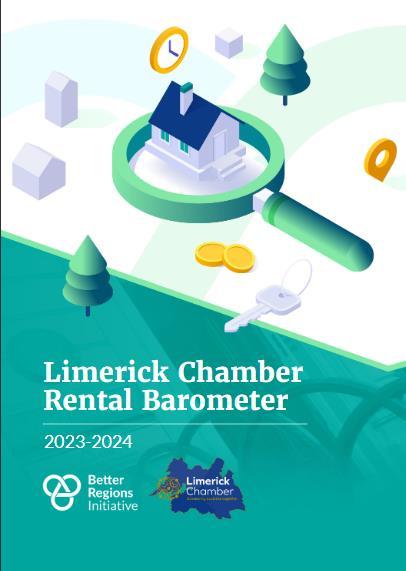

2025 EMPLOYEE HOUSING SURVEY






• Demographics & Existing Situation
• Renter Profile
• Living with Family Profile
• Happiness
• Aspirations & Desire
• Transport & Travel
• Housing Emergency?


Introduction



Limerick Chamber is pleased to present this report on the findings of our employee housing survey, which gathered the views and experiences of workers across the Limerick region. This initiative was born out of a clear need: to ensure the voice of employees - those who drive our economy, support our communities, and choose to live and work here - is not lost in the national and local housing debate.
Housing is not just a policy issue. It is a lived experience, one that shapes people’s decisions about where to build their futures, raise their families, and contribute to their local economies. Increasingly, however, the national conversation on housing supply has been dominated by units, targets, and densities. While those metrics are crucial, they can often overlook what matters most to individuals: affordability, access to amenities, family suitability, and quality of life.
In response to Government guidelines promoting increased density and apartmentled development - particularly in urban centres - we felt it vital to ask a simple but powerful question: what do employees in our region actually want when it comes to housing? This report is our answer.
We know the Government’s policy aims to support compact growth and sustainable urban development. The promotion of higher-density apartment schemes is part of a broader strategy to curb urban sprawl, reduce transport emissions, and better utilise infrastructure. However, such policy ambitions must also reflect the realities and preferences of local communities. In a region like Limerick, where population density, income levels, transport links, and lifestyle expectations differ significantly from cities like Dublin, one-size-fits-all policy risks misalignment with local needs.
The findings of this survey bring forward a crucial perspective: that of workers and families on the ground. It highlights both their current challenges - affordability pressures, long commutes, and constrained supply - as well as their future aspirations - desire for homeownership, proximity to services, and access to green space.
By giving voice to employees, we hope to better inform housing strategies that not only meet policy targets but also build the communities people genuinely want to be part of.
We are grateful to all those who participated in the survey and shared their perspectives. It is our responsibility to ensure their views inform both the policy and the practice of housing delivery in the Mid-West.
Limerick Chamber consistently contributes to housing debate and research providing bespoke evidence-based examinations of housing at a local and national level. You can find more of our work by clicking on the images below contained on the back page.

The Housing Commission calculated that Limerick will need between 2,000 (HC1) and 4,000 (HC2) homes per year to meet pent up and future demand. All housing delivery in Limerick must now be viewed through this lens.
The beginning of 2025 has been an extremely challenging year for not only the delivery of homes, but also the future pipeline of homes in Limerick.
The number of homes granted permission in H1 2025 has:
• Decreased by 43% on the same period in 2024 (H1 2024).
• Decreased by 73% compared to H1 2022.
Housing commencements were bolstered in 2024 due to the development levy waiver scheme, which many of the commencements dubbed “paper commencements”. With that in mind, the number of homes that began construction from January to July 2025 has:
• Decreased by 53% on the same period in 2024.
• Compared to 2023, 2025 is down 8%.
• Compared to 2022, commencements are down 18%.
• Compared to 2021, commencements are down 13%.
More “positively”, the number of homes completed in H1 2025 is down just 3.4% on 2024, however it is up by 14.5% and 11.3% on 2023 and 2022 respectively.
Therefore, Limerick could match its total provision from homes in 2024 in 2025, but there are serious concerns regarding 2026 and the future pipeline of home provision in Limerick.
Housing output in Limerick at the very minimum needs to double, to meet potential demand, it must quadruple. There is no observable plan in plan to get to this level of home delivery. Therefore, future housing delivery in Limerick needs to be scalable and provide mass delivery.

Housing Commencements

Housing Completions

Due to the ongoing supply issues, and the general cost of inflation, price growth in both the rental and purchase market has exploded in recent years, far outpacing general wage growth.
The Residential Property Price Index (RPPI) for the Mid-West increased by:
• 10% in July 2025, compared to the same month in 2024.
• Taking a more medium-term view, RPPI has grown by 24% since 2023, and 30% since 2022.
• Examining the case on a longer-term basis, RPPI has grown by 59% since 2019 and 139% since 2015.
The rental sector has seen far greater increases, with rents in:
• Limerick City increasing by 98% since 2019,
• While rents across Limerick County have increased by 88% since 2019. Meaning, the average annual cost for rental in Limerick is almost €30,000 per year, while Limerick County is just over €20,000 per year.

Rental Price Growth

What is affordable housing?
Affordable housing refers to several different programmes and products for housing in Ireland. The term affordable housing does not represent one homogenous scheme or result e.g. some “affordable” schemes aim to decrease the upfront cost of buying a home in exchange for the local authority or Government taking an equity stake (partial ownership of the home) whereas others like “cost rental” base their affordability on discount to market where cost rental prices must be 25% below the average market value of rent. No schemes or programmes base their affordability on what the purchaser or tenant can afford to pay relative to their income.

“Affordable” housing provision has increased in Limerick since its introduction in 2022. However, much of the emphasis has come in the form of home ownership (67% of “affordable” homes delivered in 2022 were for ownership while 59% were for ownership in 2024). It is clear there needs to be an increased focus on rental, as it is a critical step on the path to ownership.
The issue with affordable purchase through shared equity schemes is that it is not additional supply, while it might look that way in the data, these homes are developer-built homes that go on the market where purchasers can apply for a shared equity scheme to purchase the homes, they are also available to purchase without a shared equity scheme. Similarly, this is true for “affordable” delivery by Local Authorities, while it might look like these homes are being exclusively built by Local Authorities for affordable purchase, more often that not these homes were simply purchased using shared equity via the local authority and not directly delivered by the Local Authority.
Concerningly, to date, Limerick City and County Council, along with both councils in Galway, have delivered no cost rental housing – compared to small levels of delivery by Local Authorities in Dublin, Cork and Waterford. It is clear that the local authority in Limerick can play a greater role in providing additionality in the cost rental sector.
The LDA have delivered approximately 80 cost rental homes in Limerick since its inception, however, the largest share of LDA delivery has come via Dublin. The LDA also need to play a greater role in providing additionality into the Limerick housing market.


Affordable Delivery by Local Authority
Cost Rental Delivery by LDA
Summary


We surveyed almost 700 employees across the Limerick Region to better understand their existing living arrangements, and their aspirations and desire for the future. The survey was agnostic to existing tenure i.e. those living in any situation could fill out the survey from those owning, to renting, to living with parents / family.
We found that over 95% of homeowners felt their current living situation was adequate. Thus, the “target market” for this study, were those living in rental accommodation or those living with parents / family.
Key Insights
▪ Those aged 18 to 34 are more likely to rent or live with parents / family with those aged 35+ more likely to own their home.
▪ A significant portion of homeowners and renters have adult children living with them ( c. 27%), however, most of this is driven by adult children in education. 7% of homeowners have working adult children living with them.
▪ The largest cohort of renters (38%) are sharing with friends, or people they don’t know. Almost one fifth of renters cite this as an undesirable aspect of the rental market. The median number of people sharing rental accommodation is 4.
▪ Most renters are renting houses (59% of respondents), with apartment living still taking up a large share at 39%.
▪ Almost 72% of those respondents living with their parents or family have been doing so their entire lives – with no break living outside the family home. The 25 – 34 years of age cohort is the largest cohort living with parents / family (49%).
▪ Those respondents in the rental market are more unhappy than those living with parents / family – with just 28% of people renting being positive about their current situation, compared to 40% of those respondents living with parents / family.
▪ The main drivers of unhappiness by those in the rental market are 1) Cost 2) Dead money 3) Uncertainty about the future 4) Not able to decorate their space 5) Lack of security to stay 6) Low quality accommodation.
▪ Homeownership, in particular, owning a house, is the ultimate goal (94%) compared to 38% that would like to buy an apartment.
▪ Concerningly, 55% of respondents think they will never be able to afford to buy a house or apartment.
▪ In terms of desirable elements that respondents look for in a house or apartment to rent long-term, affordability ranks first followed by security of tenure, availability of car parking, green / outdoor space, space to work from home, and a furnished space – in that order.
▪ In terms of potential undesirable elements of apartment living, the lack of outdoor / private space ranks top of the list, followed by potential noise levels, limited privacy, lack of living space, lack of storage. Focusing on encouraging people to live in apartments the priorities of respondents were affordable, proximity to work, proximity to services, shops and amenities, indoor and outdoor space, as well as safety and security features. Note: Parking was excluded from this question.
▪ 77% of respondents were interested in renting affordable apartments near work. However, the availability of parking (despite the availability of public transport) influences this decision with 30% to 45% being interested in apartments with limited car parking availability. This is largely due to 80+% of respondents travelling to work by car, as well as using a car for outside work activities.
▪ 86% of respondents renting or living with parents / family think a housing emergency should be declared, this drops to 65% for the homeowner group.
Note: Depending on the grouping there can be changes in responses. For example, A larger portion of those with children think they will never be able to buy (61% versus 55%). A larger portion of those with kids would be happy to rent long term if it was more affordable and secure (53% versus 41%). Apartment purchase desire isn’t too different (31% of those with kids, versus 38% generally). Almost double those with children expect to stay living with their parents (16% with kids versus 8% generally)
Findings


Demographics & Existing Situation


Current Living Situation
Own outright / paying a mortgage Rent
Living with Parents / Family
• 95.4% of homeowners consider their current living arrangements as adequate
Age Profile - Living Situation
• 18 – 34 cohort more likely to rent or live with family
• 35+ cohort more likely to be homeowners
• Almost one third of those aged 25 –35 are living with parents / family
• Only three observations for 65+
Homeowners Renters Living with Family
Adult Children Living with Parents
Yes - attending college / further education Yes - currently working Yes - attending secondary School
• 27% of Homeowners have adult children living with them – 7% of homeowners have working adult children living with them
• Tracks similar to renter data
Other (please specify)
Renter Living Arrangements
Sharing a house / apartment with friends or others
Cohabiting with spouse / partner (no children)
Cohabiting with spouse / partner and children
Living on my own
Living with children only (no spouse / partner)
Other
Renter Profile


Time Spent in Rental Accommodation
6 YEARS
Average time spent so far in rental accommodation for existing renters
3 YEARS
Median time spent so far in rental accommodation for existing renters
Type of Rental
Other (please specify)
• Significant share of renters live in apartments at 39% • Houses make up 59%
4 PEOPLE
Median number of people sharing an apartment or house rental
Living with Family Profile


Living with Family
How long have you lived with family?
Entire Life 3 years and under 3 - 6 years 7+ years
Age Demographics - Living with Family
Happiness


Renter Happiness
Thinking about living in rented accommodation, to what extent are you happy with this arrangement?
I am very happy / content I am generally happy / content I am neutral about it I am generally negative about it I am very negative about it
• 46.7% are negative about renting
• 28.2% are positive about renting
Renter Current Dislikes
What aspects of renting do you not like? Select a maximum of five options



Cost of Renting Dead Money No Decorating Lack


Uncertainty About the Future

Living with Family Happiness
Thinking about living with family, to what extent are you happy with this arrangement?
I am very happy / content I am generally happy / content I am neutral about it I am generally negative about it I am very negative about it
• 37.7% are negative about renting
• 40.0% are positive about renting
Family Current Dislikes
What aspects about living with parents / family do you not like? Select a maximum of five options



Lack of privacy / space Feeling trapped due to housing costs Not being able to afford independence


Uncertainty about the future Space

How to interpret: 66% of respondents ranked the lack of space / privacy as being in their top 5 dislikes
Aspirations & Desire


Aspirations
I would rather rent longer term than buy
I intend to stay living in rented accommodation I intend to stay living with parents / family
I will definitely buy a house or apartment in the next two years
I would be happy to rent long-term it was affordable and I had some security about staying as long as I want I would like to buy an apartment
I don’t think I will ever be able to afford to buy a house / apartment I will aim to live in a better standard of rented accommodation
Ultimately I want to stop renting and buy
I would like to buy a house
Agree Neutral Disagree
• Homeownership, in particular, owning a house, is the ultimate goal (94%).
• 55% think they will never be able to afford to buy a house or apartment
• Desire to rent longer-term increases with affordability and security
• Only a third believe they will definitely buy a house or apartment in the next two yeas
How to interpret: 94% of respondents would like to buy a house
Desirable Elements
Thinking about a house or apartment you might rent for the longer term, which of the following elements would you want to have? Please select a maximum of five options



Affordable Secure Tenure



How to interpret: 83% of respondents ranked affordable as being in their top 5 desirable elements
Desirable Elements
Which of the following factors would encourage you to live in an apartment? Please select a maximum of five options (*excluding car parking)






How to interpret: 63% of respondents ranked affordable as being in their top 5 desirable elements
Concerns
Which of the following concerns might discourage you from living in an apartment? Please select a maximum of five options



Lack of outdoor / private space Noise Levels Limited Privacy



Lack of Parking
• 7% have no concerns around apartment living
How to interpret: 54% of respondents ranked lack of outdoor / private space as being in their top 5 concerns
Affordable Apartments
If affordable apartments were available near your workplace, how interested would you be in living there?
Affordable in an Irish context means rent that is 25% less than current market rents
Interested Not Interested Neutral
• Huge support for affordable apartments, but not as big as you would think.
Transport Patterns


Transport
How do you usually travel to work?



• “Other” is E-bike, scooter, motorbike and Train



Transport
How do you usually travel to work?



Car Bus Walk



• Car most popular across all age cohorts
• Renters and those living with family less likely to work from home than homeowners
How to interpret: 82.2% of respondents primarily use a car to travel to work
Cars & Public Transport
Why do you normally commute to work by car rather than public transport?
My work place is not on a bus route
I need a car during the day
I need to collect / drop children
Past experience of public transport has not been positive
I don't want to use public transport
“Other” = living rurally, travel for work, company card, bus stop to long of a walk, public transport takes too long, bus times do not suit, convenience
I visit shops etc. while out
Attractiveness of Limited Parking
Would you consider living in an apartment building that offers limited or no private car parking, if it has good access to public transport and shared mobility options (e.g., car share, bike share)?
If you were able to find appropriate accommodation (with limited car parking) that meant you could readily commute on public transport, and not have to own / use a car, how attractive an option would this be to you?
Maybe / Neutral = depends on frequency of public transport, offsite parking, low cost parking but not free, safety, security, noise, proximity to work
Unattractiveness of Limited Parking



Need a car for outside work trips

Need a car for shopping Public transport would only suit some trips


Need a car for children Public transport too slow Public transport Overcrowded
How to interpret: 81.3% do not like the thought of not owning a car or having space for a car because they need to use it for trips outside work
Housing Emergency?


Housing Emergency ?
Do you think a housing emergency should be declared?
Homeowners
UNSURE
Renters & Living with Family
UNSURE
The Housing Trap
Would like to Buy
Can’t afford to buy
Rent
Rental costs too high
Can afford to buy
Live with Family
Costs still too high / supply an issue
Can save
Rental costs allow a person to save
Read More of our Housing Research








